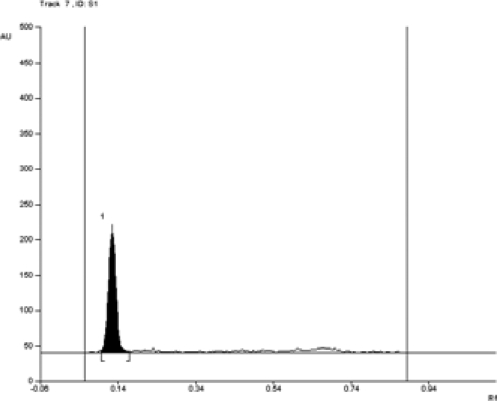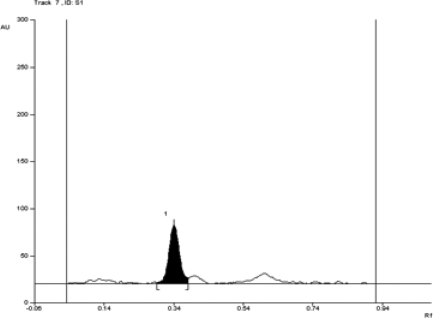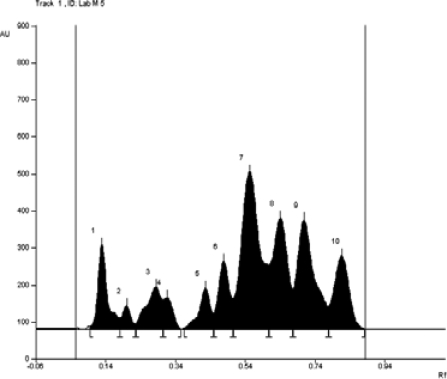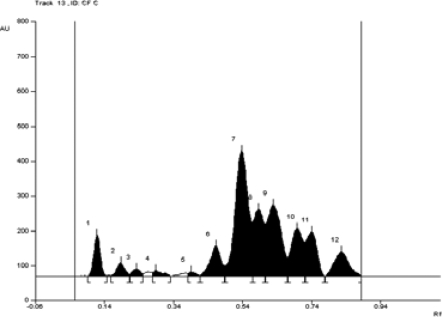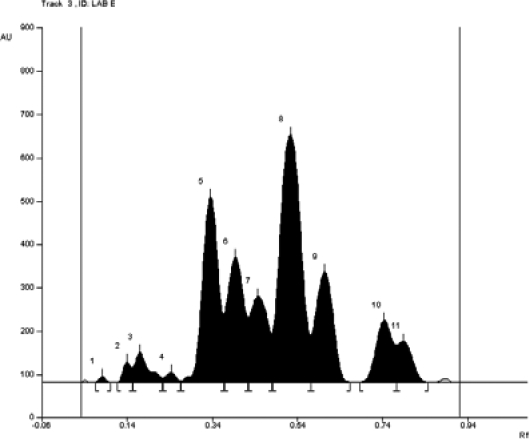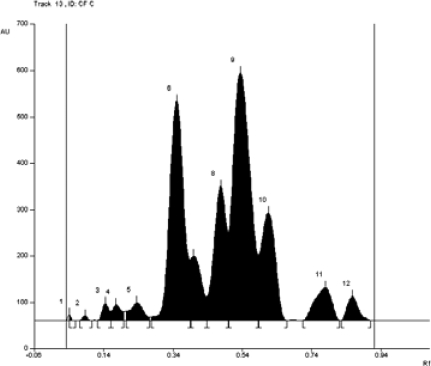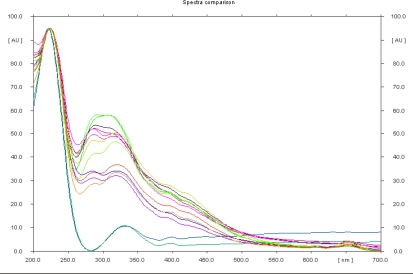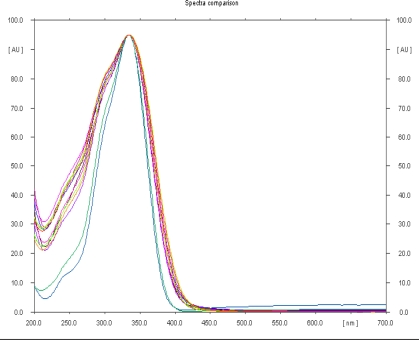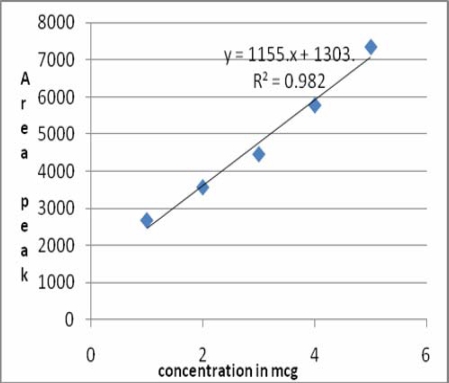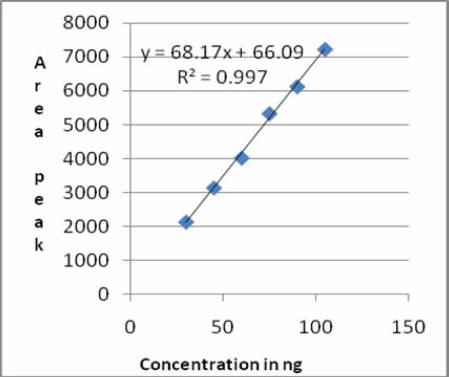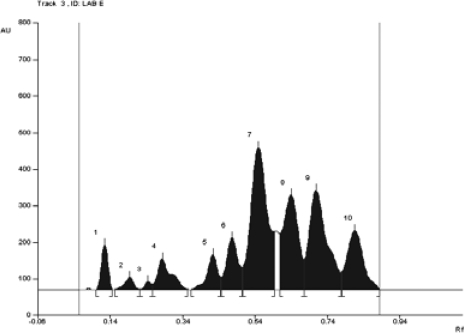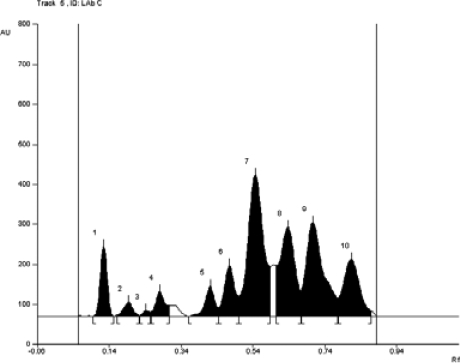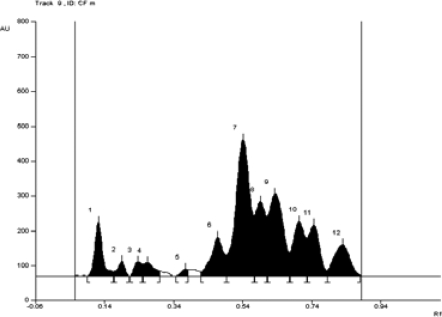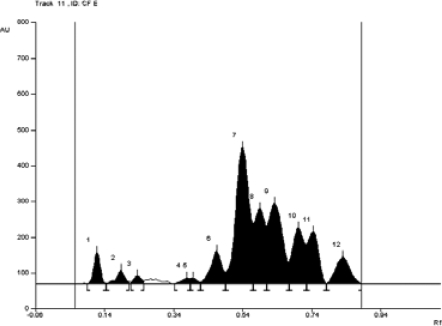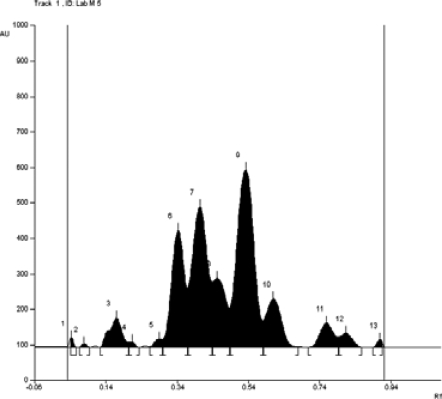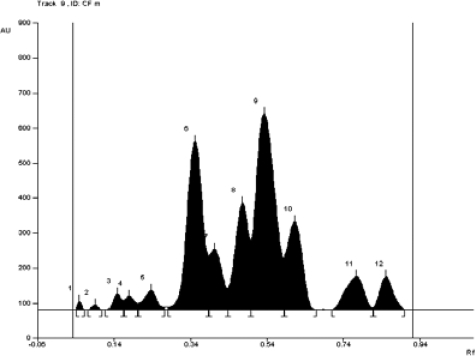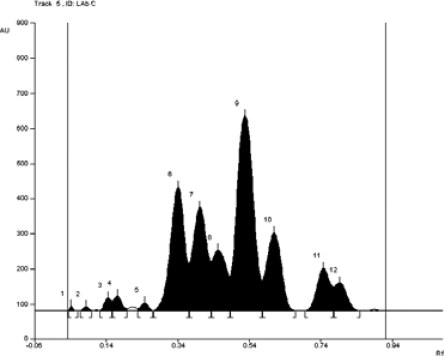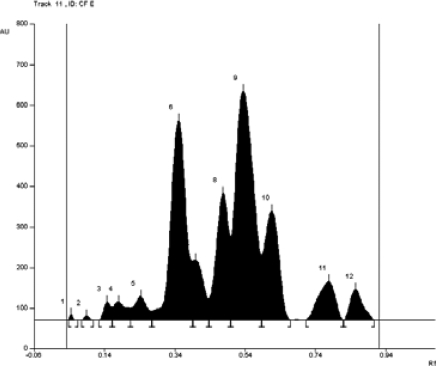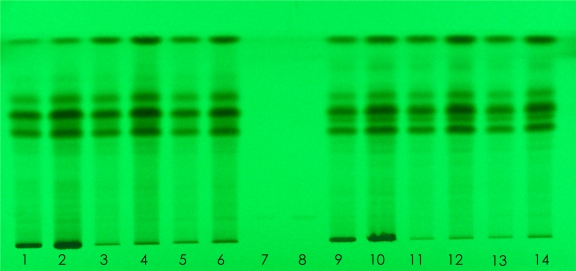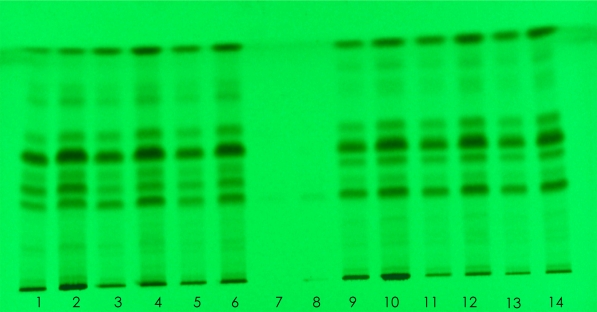Abstract
Amukkara curanam, a Siddha formulation, currently used in all types of gastric disorders, rheumatic pain, insomnia and sexual insufficiency, was investigated for the estimation of the marker compounds, withaferine A and piperine contents in a prepared standard formulation and a commercial formulation by using HPTLC method of analysis. The two formulations were subjected to methanol, ethyl acetate and chloroform extractions by using Soxhhlet apparatus The chromatogram was developed using chloroform: methanol (8.5:1.5 v/v) and toluene: ethyl acetate (7:3 v/v) as mobile phases for the estimation of withferine A and piperine respectively. The detection and quantification were performed at a wavelength of 220 nm for withaferine A and 254 nm for piperine. The linear regression analysis of calibration plots of withferine A and piperine exhibited linear relationship in the range of 5 – 15 µg and 50 – 150 ng respectively, while the % recovery was found to be 94.52% w/w of withaferine A and 98.73%w/w of piperine, thus proving the accuracy and precision of the analysis. Methanol and ethyl acetate were found to be the suitable solvents for the extraction of withaferin A and piperine respectively. The withaferine A content in standard formulation was found to be much higher in all the three extracts than that of the commercial sample. However, the piperine content in all the three extracts of standard formulation was slightly lower than the respective extracts of commercial formulation. The proposed HPTLC method was found to be rapid, simple and accurate for quantitative estimation of withferine A and piperine in different formulation extracts.
Keywords: HPTLC, Amukkara Curanam (AKC), Withaferine A, Piperine, Standard Formulation (SF), Commercial Formulation (CF)
Introduction
Herbal medicine has witnessed a renaissance among the customers throughout the world. The recent upsurge of interest in Siddha system, an ancient system of Indian Medicine practiced in southern parts of India can be seen by the large scale manufacture of Siddha formulations. However, one of the impediments in the acceptance of the ancient systems of medical preparation is the lack of standard quality control profiles (Bagul and Rajani, 2005). During a study, the amount of withaferin A — one of the withanolides of ashwagandha — was analysed in 10 products being sold in the market. Withanolides are secondary metabolites produced by the plant. The scientists assumed withaferin A to be an indicator of the presence of ashwagandha. They found that the amount of the chemical per gramme of ashwagandha varied from 100 per cent to merely 0.9 per cent. In nine of the products, the quantity was less than 50 per cent. This research highlights the importance of standardizing herbal products (Down to Earth, 2004). In spite of the large number of herbal formulations available in the market, standards for their quality are yet to be laid for many of them (Eapen Saumy M.S, et al 2002; Patel K.N, 1996). It is therefore, imperative to develop fast, sensitive and accurate quality control tests for Siddha formulations which will be in alignment with modern technology. The quality of herbal medicine, that is, the profile of the constituents in the final product has implication in efficacy and safety. Due to the complex nature and inherent variability of the chemical constituents of the plant based drugs, it is difficult to establish quality control parameters and modern analytical techniques are expected to help in circumventing this problem. It was observed that Amukkara curanam has been frequently prescribed not only by Siddha physicians but also by Ayurvedic and Allopathic physicians for treating rheumatism and various nervous disorders. In the literature survey no scientific study has been conducted to standardize this curanam so far. Hence, a scientific investigation was undertaken to evaluate Amukkara curanam.
This research paper describes the evaluation of Amukkara curanam through the estimation of marker compounds, withaferine A and piperine. The formulation is official in Siddha Formulary of India, Part I (The Siddha Formulary, 1992) and therapeutically useful in the treatment of all types of gastric disorders, leucorrhoea, anaemia, tuberculosis, rheumatic pain, insomnia and sexual insufficiency. It consists of one gram of ‘Kirambu’ - Clove [Eugenia cryophyllus Thunb. (Fam:Myrtaceae)], two grammes of ‘Cirunakappu’- Mesua [Mesua ferrea auct. non L (Fam:Clusiaceae)], four grammes of ‘Elam’- Cardamom (Elettaria cardamomum L (Fam:Zingiberaceae)], eight grammes of ‘Milaku’- Black pepper (Piper nigrum Linn.(Fam: Piperaceae)] sixteen grammes of ‘Tippili’- Long pepper [Piper longum Linn.(Fam: Piperaceae)], thirty two grammes of ‘Cukku’- dried Ginger [Zingiber officinalis Roscoe(Fam: Zingiberaceae)] and sixty four grammes of ‘Amukkara’- Aswagandha [Withania somnifera (L) Dunal. (Fam. Solanaceae)]. The withaferin A in Withania somnifera and piperine in Piper longum and Piper nigrum are reported to be the active components in the formulation and can be considered as marker compounds. Therefore, HPTLC method has been developed for the estimation of these marker compounds (Sethi, P.D, 1996) and also to develop finger print profile for the standard formulation of Amukkara curanam, so that these parameters can be compared with any commercial formulation available in the market for evaluating its purity and quality. The proposed method has been validated as per ICH guidelines (ICH, 1994 and 1996).
Materials and Methods
Chemicals
Analytical Reagent grade toluene, ethyl acetate, methanol and chloroform were obtained from S.D.Fine Chem Ltd.(Mumbai, India). Pure withaferine A and Piperine were obtained from Natural Remedies Ltd, (Bangalore, India) as gift samples. Pre-coated silica gel 60 F254 TLC aluminium plates (10 × 10 cms, 0.2 mm thick) were obtained from E.Merck Ltd. (Mumbai, India).
Drugs
Clove (Eugenia cryophyllus - flower bud), Mesua, (Mesua ferrea - flower) Cardamom (Elettaria cardamomum - fruits), Black pepper (Piper nigrum - dried fruit), Long pepper (Piper longum - dried fruit root), Ginger (Zingiber officinalis - dried rhizome) and Withania (Withania somnifera - dried root) were purchased from the local market and authenticated by the Department of Pharmacognosy, Annamalai University, Annamalai Nagar, Tamil Nadu, India. The commercial formulation- Amukkara curanam - was obtained from Indian Medical Practitioners' Co-operative Pharmacy (IMPCOPS), (Chennai, India).
Preparation of Standard Withaferine A Solution
A reference standard solution of withferine A (200 µg/ml) was prepared by dissolving 2 mg of accurately weighed withferine A in methanol by sonication in ultrasonic water bath to dissolve and making up the volume to 10 ml with methanol.
Preparation of Standard Piperine Solution
A stock solution of piperine (1mg/ml) was prepared by dissolving 10mg of accurately weighed piperine in methanol and making up the volume to 10ml with more methanol in amber coloured volumetric flask covered with aluminium foil, since piperine in solution isomerizes to isopiperine, chavicine and isochavicine on exposure to light. (Dipal Kulkarni, et al, 2001). The stock solution was further diluted with methanol to give a standard solution of piperine (15 ng/mcl).
Chromatographic Conditions (For withaferine A)
| Stationary phase | : | Pre-coated silica gel 60F254 TLC plate (10 × 10 cms, 0.2 mm thickness). |
| Mobile phase | : | Chloroform: Methanol (8.5:1.5 v/v) |
| Saturation time | : | 15 minutes |
| Wavelength | : | 220 nm |
| Lamp | : | Deuterium |
Chromatographic Conditions (For piperine)
| Stationary phase | : | Pre-coated silica gel 60F254 TLC plate (10 × 10 cms, 0.2 mm thickness) |
| Mobile phase | : | Toluene: Ethyl Acetate (7:3 v/v) |
| Saturation time | : | 15 minutes |
| Wavelength | : | 254 nm |
| Lamp | : | Deuterium |
Calibration Curves
The standard solutions (5–15 mcg per respective spot) were applied in triplicate on TLC plate. The plate was developed and scanned as per the chromatographic conditions mentioned above. The peak areas were recorded. Calibration curve of withferine A was prepared by plotting peak areas vs. concentrations of withaferine A applied. Similarly calibration curve was prepared for piperine using standard solutions (30 – 150 ng per respective spot).
Preparation of Amukkara curanam
Amukkara curanam was prepared in the laboratory using the authenticated ingredients. (Siddha Formulary of India” Part I, 1992). The individual drugs were powdered separately and sieved through a fine mesh. Then the required quantities by weight were taken and thoroughly mixed to uniformity.
Preparation of Extracts
The SF samples (10 gm each) and the CF samples (10 gm each) of AKC were extracted for six hours separately by using three different solvents, methanol, ethyl acetate and chloroform in a Soxhlet apparatus. All the six extracts were then concentrated at a temperature, below 50°C, filtered through Whatman filter paper No1 and the final volumes were made up to 10ml with respective solvents.
Analytical Procedure
Methanol, ethyl acetate and chloroform extracts of SF and CF of Amukkara curanam and standard solutions of withferine A and piperine were spotted on a 10 × 10 cm precoated TLC plates as 6 mm wide band and 8 mm from the bottom by using Linomat V. The plates were developed in a twin trough chamber, under the chromatographic conditions given above, by ascending mode to a distance of 8 cm under chamber saturation conditions. After development the plates were dried in air and scanned at 220 nm for withaferine A and at 254 nm for piperine by using CAMAG Scanner III. The plates were photographed at 254 and 366 nm by using CAMAG Reprostar (Photoplate I&II). The contents of withaferine A and piperine in the SF and CF of methanol, ethyl acetate and chloroform extracts of the two formulations were calculated from the respective calibration curve.
Results
Standard withferine A (Max.Rf:0.12) and piperine (Max.Rf:0.34) showed single peaks in HPTLC chromatogram. (Figures 1 and 2). The spot at Rf: 0.12 corresponding to withaferine A (Figures 5 –10) and the spot at Rf: 0.34 corresponding to piperine (Figures 12 – 17) were observed in the respective chromatograms of the extracts of SF and CF. There was no interference from other components present in the formulation. Good correlation was also obtained between standard and samples overlay spectra of withaferine A (Figure 11) and piperine. (Figure 18) Calibration curves were prepared by plotting concentrations versus average area of the peak. (Fig 3 and Fig 4). The linear regression analysis of calibration plots of withferine A and piperine exhibited linear relationship in the range of 5 – 15 mcg and 50 – 150 ng respectively with the correlation coefficient of 0.982 and 0.997 for withaferine A and piperine respectively and thus exhibits good linearity between concentration and area (Table 4).
Figure 1.
Chromatogram of standard withaferine A
Figure 2.
Chromatogram of standard piperine
Figure 5.
Chromatogram of Methanol ext. of AKC (SF)
Figure 10.
Chromatogram of Chloroform ext. of AKC (CF)
Figure 12.
Chromatogram of Methanol ext. of AKC(SF)
Figure 17.
Chromatogram of Chloroform ext. of AKC(CF)
Figure 11.
Spectra comparision for withaferine A: Purity(nm)
Figure 18.
Spectra comparison for Piperine: Purity (nm)
Figure 3.
Calibration curve of withaferine A
Figure 4.
Calibration curve of piperine
Table 4.
Results of Validation Method
| Sl.No | Analytical Method | Accuracy(% recovery) |
Precision. (S.D) |
Linearity | Coefficient of variation % (CV) |
| 1 | HPTLC of WA | 94.52 | 0.7435 | 01–05mcg | 0.1737 |
| 2 | HPTLC of PP | 98.73 | 0.1465 | 30 –105ng | 0.5529 |
Figure 6.
Chromatogram of Ethyl acetate ext. of AKC (SF)
Figure 7.
Chromatogram of Chloroform ext. of AKC (SF)
Figure 8.
Chromatogram of Methanol ext. of AKC (CF)
Figure 9.
Chromatogram of Ethyl acetate ext. of AKC (CF)
Figure 13.
Chromatogram of Et.A ext. of AKC(SF)
Figure 14.
Chromatogram of Chloroform ext. of AKC(SF)
Figure 15.
Chromatogram of Methanol ext. of AKC(CF)
Figure 16.
Chromatogram of Et.A ext. of AKC(CF)
Recovery study was carried out by spiking the preanalysed samples with pure withaferine A and piperine. The percentage recovery of withaferine A and piperine were found to be 94.52 and 98.73 respectively which are highly satisfactory (Tables 2 and 3). The limit of detection was determined by signal to noise ratio which was found to be 150 ng/spot for withaferine A and 15 ng/spot for piperine. The formulation samples were analyzed by the proposed method. The data from Table 1 revealed that the withferine A contents in methanol, ethyl acetate and chloroform extracts were found as 0.037%w/w, 0.013%w/w and 0.023%w/w respectively in SF sample and 0.0237%w/w, 0.0037%w/w and 0.013%w/w respectively in CF sample of Amukkara curanam. Similarly, the piperine content in methanol, ethyl acetate and chloroform extracts were found as 0.347%w/w, 0.363%w/w and 0.342%w/w respectively in SF sample and 0.377%w/w, 0.383%w/w and 0.375%w/w respectively in CF sample of Amukkara curanam.
Table 2.
Results of Recovery study of the method for Withaferine A (WA)
| Sl.No | Amount of sample taken (mg) A |
Amount of WA in A (ng) B |
Amount of WA added to A (ng) C |
Amount of WA taken B+C (ng) D |
Total WA found (Mean±SD, n=5) (ng) E |
% Recovery E/D X 100 |
| 1 | 1100 | 387 | 50 | 437 | 417 ±9.8234 | 95.32 |
| 2 | 1200 | 435 | 100 | 535 | 505 ±13.45 | 94.39 |
| 3 | 1300 | 462 | 150 | 612 | 605 ± 11.497 | 93.85 |
| Average Recovery: 94.52% | ||||||
Table 3.
Results of Recovery study of the method for Piperine (PP)
| Sl.No | Amount of sample taken(mg) A |
Amount of Piperine in A (mg) B |
Amount of Piperine added to A (mg) C |
Amount of Piperine taken B+C (mg) D |
Total Piperine found(Mean±SD, N=5) (mg) E |
% Recovery E/D X 100 |
| 1 | 1100 | 22.26 | 2 | 24.26 | 24.04±0.1139 | 99.03 |
| 2 | 1200 | 22.38 | 5 | 27.38 | 27.10±0.1392 | 98.37 |
| 3 | 1300 | 22.58 | 10 | 32.58 | 32.16±0.1530 | 98.71 |
| Average Recovery: 98.73 | ||||||
Photo plate I scanned at 254nm (Estimation of withaferine A in AKC)
1. SF - Methanol ext. 5mcl, 2. SF - Methanol ext. 10mcl, 3. SF - Et. Acetate ext. 5mcl, 4. SF - Et. Acetate ext 10mcl; 5. SF - Chloroform ext. 5mcl 6. SF - Chloroform ext. 10mcl, 7. Standard WA 5mcl, 8. Standard WA 10 mcl; 9. CF - Methanol ext. 5 mcl, 10. CF - Methanol ext. 10 mcl, 11. CF - Et. Acetate ext 5mcl, 12. CF - Et. Acetate ext 10 mcl, 13. CF - Chloroform ext 5 mcl, 14. CF - Chloroform ext 10 mcl
Figures 12 to 17 are chromatograms of various extracts of SF and CF of Amukkara curanam for piperine content
Photo plate II scanned at 254nm (Estimation of piperine in AKC)
1. SF - Methanol ext. 5mcl, 2. SF - Methanol ext. 10mcl, 3. SF - Et. Acetate ext. 5mcl, 4. SF - Et. Acetate ext 10mcl; 5. SF - Chloroform ext. 5mcl, 6.. SF - Chloroform ext. 10mcl, 7. Standard PP 5mcl, 8. Standard PP 10 mcl. 9. CF - Methanol ext. 5 mcl, 10. CF - Methanol ext. 10 mcl, 11. CF - Et. Acetate ext 5mcl, 12. CF - Et. Acetate ext 10 mcl, 13. CF - Chloroform ext 5 mcl, 14. CF - Chloroform ext 10 mcl
Discussion
The study revealed that methanol is a better solvent to extract withferine A than other two solvents though they also extracted withaferine A to a considerable extent. In the past studies only methanol was used for the extraction of withaferine A (Ganzera et al, 2003), but the present study revealed that ethyl acetate and chloroform also can extract withaferine A. Similarly, ethyl acetate was found to be a better solvent to extract piperine from the formulation than the other two solvents though they also useful in the extraction of piperine. The withaferine A content in SF was much higher in all the three extracts than that of the CF sample indicating the superiority of SF. It has been suggested from the study that quality control should be introduced in the production process at the raw material stage itself. However, the piperine content in all the three extracts of SF were slightly lower than the respective extracts of CF. It may be due to varied factors like improper selection of the drug variety, incorrect identification of the drug, variation in the weight of the drug added to the formulation, addition of exhausted material and processing. It is revealed, from the above data, that the marker compounds, withaferine A and piperine content estimated are in agreement with the published data (Ganzera M, et al. 2003; Kokate et al., 1997)).
Conclusion
The proposed HPTLC method was found to be rapid, simple and accurate for quantitative estimation of Withaferine A and piperine in different formulation extracts. The recovery values of withaferine A and piperine were found to be 94.52% and 98.73% respectively, which shows the accuracy of the method. The method was found to be useful in detecting the genuineness of the formulation and thus suitable to evaluate various AKC formulations available in the market. The finger print profiles of various chromatograms obtained from the different extracts of SF of AKC may be utilized for comparison and evaluation of commercial samples of Amukkara curanam.
Table 1.
Withaferine A and Piperine contents in different extracts
| Sl.No. | Extracts | % w/w Withaferine A | % w/w Piperine |
| 1 | SF - Methanol ext. | 0.037 | 0.346 |
| 2 | SF - Ethyl acetate ext. | 0.013 | 0.363 |
| 3 | SF - Chloroform ext | 0.023 | 0.342 |
| 4 | CF - Methanol ext. | 0.024 | 0.377 |
| 5 | CF - Ethyl acetate ext. | 0.004 | 0.383 |
| 6 | CF - Chloroform ext | 0.013 | 0.375 |
Acknowledgment
The authors are thankful to the authorities of Sri Ramachandra University, Chennai, Tamil Nadu, India, for providing HPTLC facilities to carry out this project. Also, they are grateful to Natural Remedies, Bangalore, India, for providing gift samples of standard compounds.
References
- 1.Bagul MS, Rajani M. Phytochemical Evaluation of Classical Formulation – A Case Study. Indian Drugs. 2005;42(1):15–19. [Google Scholar]
- 2.Kulkarni Dipal, Apte Sukhada P, Mary Francis, Sane RT. HPTLC method for the determination of Piperine from Piper nigrum, Linn. Indian Drugs. 2001;38(6):323–325. [Google Scholar]
- 3.Down to Earth, author. Quality control for India's herbal drugs. 2004. (online), cited 22 April 2007, www.SciDev.NetHome.
- 4.Saumy Eapen MS, Grampurohit ND. Chemical Evaluation of Navayasa churna. Indian Drugs. 2002;39(2):101–105. [Google Scholar]
- 5.Ganzera M, Choudhary MI, Kaul A. Quantitative HPLC analysis of withanolides in Withania somnifera. Fitoterapia. 2003;74:68–76. doi: 10.1016/s0367-326x(02)00325-8. [DOI] [PubMed] [Google Scholar]
- 6.ICH, Q2A, author. Proc Int Con Harmonization. Geneva: 1994. Validation of analytical procedure: Methodolo. [Google Scholar]
- 7.ICH, Q2B, author. Proc Int Con Harmonization. Geneva: 1996. Validation of analytical procedure: Methodolo. [Google Scholar]
- 8.Kokate CK, Purohit AP, Gohale SB. Chapter-9, Drugs Containing Tannins in Text Book of Pharmacognosy. Fifth Edition. Pune, India: Published by Nirali Prakashan; 1997. pp. 461–464. [Google Scholar]
- 9.Patel KN. Solutions to problems associated with herbal drugs and their formulations. Pharma Plus. 1996;1(1):9–11. [Google Scholar]
- 10.Sethi PD. High Performance Thin Layer Chromatography. 1st Edition. New Delhi, India: CBS Publishers and Distributors; 1996. pp. 3–71. [Google Scholar]
- 11.The Siddha Formulary of India, author. Part I, First Edition, Formulary - Chapter No. 21. Curanams. New Delhi: Published by Department of Health, Ministry of Health and Family Welfare, Govt. of India; 1992. pp. 151–156. [Google Scholar]



